Finding out the sex of a dinosaur might seem a little pointless, but it could teach us a lot about how these ancient animals lived.
Yet is it even possible to sex a dinosaur?

While Dippy is referred to as a ‘he’, it is impossible to know what sex the original fossil actually is © The Trustees of the Natural History Museum, London
Finding out the sex of a dinosaur might seem a little pointless, but it could teach us a lot about how these ancient animals lived.
Yet is it even possible to sex a dinosaur?
We know from animals alive today that individual species can look very different to each other. The way some animals look also varies depending on their observed sex. This phenomenon is known as sexual dimorphism.
When researchers discover new dinosaur fossils, they need to compare them carefully with other fossils that have already been found. This is because any differences they might observe in their new specimen could be due to several factors.
Substantial differences might mean that the new specimens come from a new species, but they could look different because the dinosaur is older or younger than those previously found. After all, baby dinosaurs changed as they grew up.
It’s also possible that these differences could be due to sexual dimorphism, but this has proved surprisingly difficult to study.
One of the main problems is simply that the sample sizes for many species are too small. There are only a few dozen dinosaur species for which more than 10 individuals have ever been found and even then, the specimens need to be complete enough that precise details can be compared.
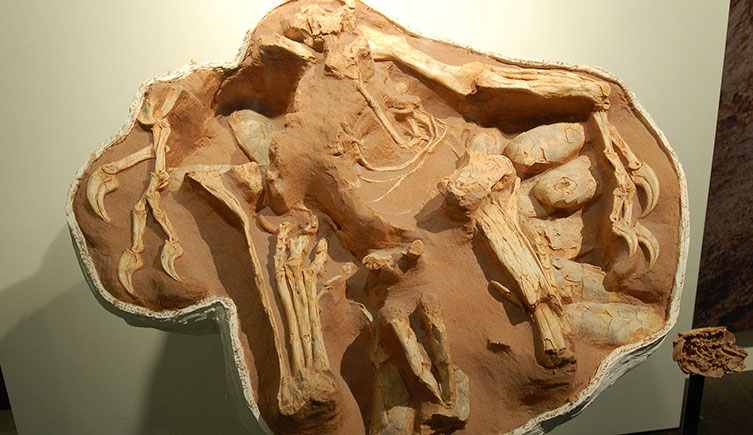
The only way to definitively sex a dinosaur is to find one with eggs still inside it, but even then they need to be in the right place. © Dinoguy2/Wikimedia Commons
Professor Paul Barrett is a dinosaur researcher at the Natural History Museum who mostly works on herbivorous dinosaurs.
“It’s very rare to be able to sex a dinosaur definitively,” says Paul. “Various people have tried, but at the moment the only really good way to sex a dinosaur is to find one with eggs still inside it.”
This would clearly show if an individual was female, but “only if the eggs are in the lower part of the body rather than in the stomach area,” explains Paul. Otherwise, it’s possible that those eggs were lunch.
Researchers have also tried to sex dinosaur fossils by other means. Some have looked inside the bones for a type of tissue known as medullary bone.
As female birds prepare to lay eggs they take some of the calcium from their skeletons, depositing it as medullary bone, which can be rapidly dissolved in the blood stream and used to make eggshell when the time comes. Researchers thought that if this tissue was found in dinosaur bones, it would be indicative of a female dinosaur that died as it was preparing to lay eggs.
But recent studies suggest that medullary tissue might also be formed when an animal is exposed to environmental stresses. This has still not been resolved.
“There aren’t any definitive ways of telling if something is male, and at the moment the only things that might identify a female will only work if that female was close to or actually laying eggs,” says Paul.
But that’s not to say that no one has tried to identify male dinosaurs.
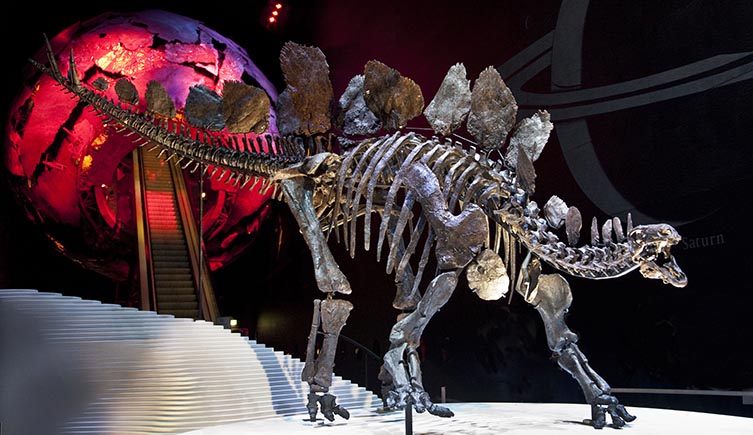
We don’t know. The specimen was named after the daughter of the donor who made it possible for the Natural History Museum to acquire this important skeleton.
Find out what we do know about this Stegosaurus.
The first person to really start considering sexual dimorphism in dinosaurs was Franz Nopcsa. The Transylvanian baron, born in 1877, started thinking beyond what dinosaurs looked like into how they behaved.
“He was the first person to think of these creatures as biological entities rather than just describing them as new types of animal,” says Paul. “He considered their palaeobiology.”
As part of this, Nopcsa studied the structure of dinosaur populations and began developing a theory about sexual dimorphism. Looking specifically at the crested hadrosaurs and horned ceratopsians, he believed that different shapes and arrangements of the horns, frills, knobs and crests on their skulls represented differences in male and female anatomy.
He thought that he could identify similar dinosaurs living in the same time and place that differed only in their physical features, and so thought they might have been sexual dimorphs.
Unfortunately for Nopcsa, it turned out that many of the male/female pairs he identified lived during different time periods, and so more likely represented different evolutionary lineages rather than different sexes. But his foray into sexual dimorphism still made a lasting impression on palaeontology.
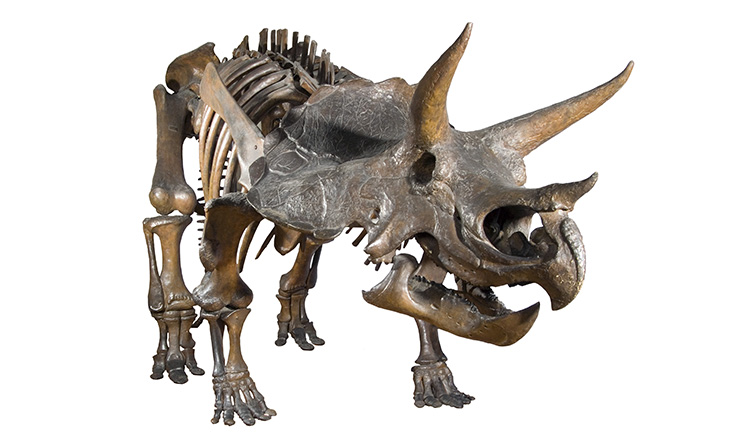
Nopcsa thought that he had identified sexual dimorphism among ceratopsians, such as Triceratops. © The Trustees of the Natural History Museum, London
“It was an interesting idea, and one that was ahead of its time,” says Paul. “Although he got it wrong, sexual dimorphism is now one of the criteria we use when we’re assessing whether something really is a new species or just within the range of variation of what a species might look like.”
This was not Nopcsa’s only delve into sexing dinosaurs. In 1905 he proposed the existence of a sauropod baculum, or penis bone. He believed that what had previously been identified as a sauropod clavicle was misidentified and that actually it was a bone found within the penis. No one really took this argument seriously.
In recent years some researchers have suggested that the shape of two little bones at the base of the tail in some dinosaurs, known as chevrons, might be used to identify males. This is because male crocodiles have slightly larger chevrons than females to act as an anchor point for the muscles of the penis.
But when dinosaur chevrons were compared, their sizes didn’t appear to be distributed into two neat groups.
Rather than looking to the bones for differences between the sexes, researchers should probably be searching elsewhere. It seems likely that some dinosaur species were using other secondary sex characteristics such as feathers and colour to differentiate themselves.
“We know that lots of dinosaurs were feathered, and we know that in lots of reptiles where they have dimorphism it’s often colour-based,” explains Paul. “So it could be that feathered dinosaurs were using their feathers for display.”
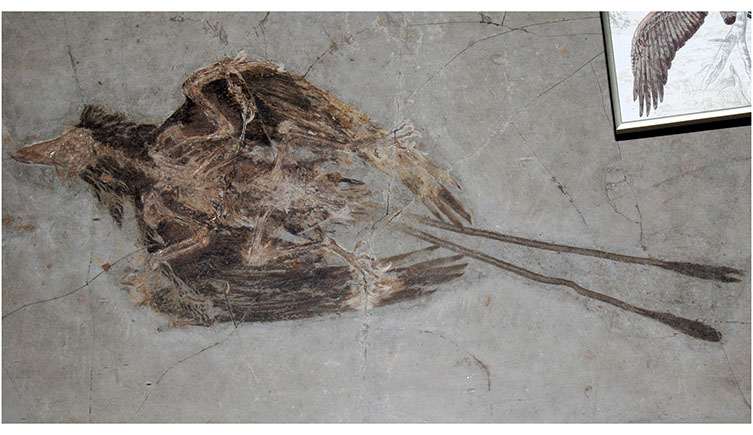
About half of all Confuciusornis fossils have long pendant tails, and so these are assumed to have been males. © Tommy from Arad/Wikimedia Commons
One of the leading theories as to why feathers evolved in the first place is that they may have developed primarily as a display tool.
“The first therapod dinosaurs that developed feathers did so on their forearms and their tails,” says Paul. “Places that are easy to move for visual displays. It’s very noticeable.”
“You can image these small feathered theropods doing little dances with each other, where they’re shaking their arms and puffing out their feathers. At the same time they might have a tail fan and be doing a little peacocking by shaking it.”
There’s one exceedingly rare example of an extinct dinosaur, albeit a bird, that shows that some species were clearly sexually dimorphic in their feathers.
Confuciusornis was a crow-sized bird that lived 127-121 million years ago during the Early Cretaceous period in what is now China. The fossils of these birds are preserved in astonishing detail, including soft tissue and feathers.
It’s now thought that the males of the species had beautifully long pendant tail feathers, while the females had much shorter ones.
“We suspect that they were the males because the fossils are detailed enough, and there is roughly a 50/50 ratio of birds with long feathers to those without,” explains Paul.
Over the last few decades, thousands of specimens of Confuciusornis have been unearthed, allowing researchers the rare chance to conduct population-level studies of the extinct birds, something that is not possible for most species of dinosaur.
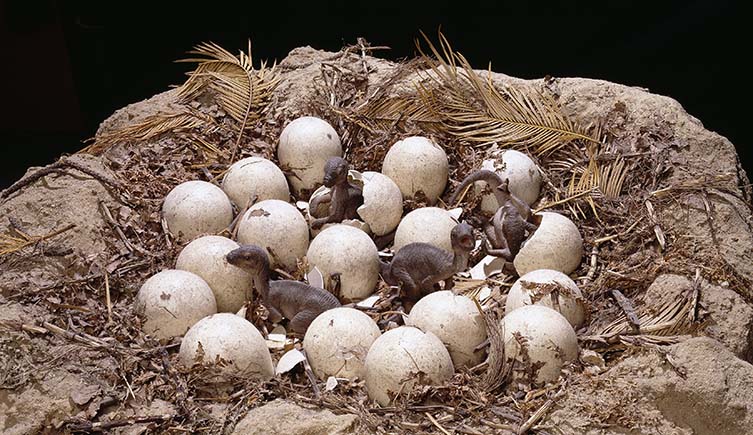
Maiasaura was named ‘good mother lizard’ because its fossil remains were found on the top of nests and it was assumed that the individuals were displaying parental care. © The Trustees of the Natural History Museum, London
The current inability to sex most dinosaurs not only impacts how species are described but can feed into a bias in how researchers interpret these fossils and any potential behaviour associated with them.
“By default, most dinosaurs have been named with the masculine ending ‘saurus’,” says Paul. “I’m guessing that,s because a lot of people think of dinosaurs as big, hulking, brutish things and so they generally think in the male sense when they think of these animals.”
But there are one or two dinosaurs that are named very specifically with a female ending. This is either because they are named after a woman, or because the researchers wanted them to have a particular feminine quality.”
The most obvious example of this is Maiasaura, which translates as ‘good mother lizard’.
Maiasaura was a large duck-billed hadrosaur and was only named with a feminine suffix because its remains were found on top of nests, making it one of the first dinosaurs known to exhibit parental care. As parental care has traditionally been deemed a feminine attribute, so Maiasaura was named.
Whether or not researchers will ever be able to accurately sex dinosaurs is hard to tell. Unless there are lots more individuals found, it seems likely that most dinosaur remains will remain unsexed.
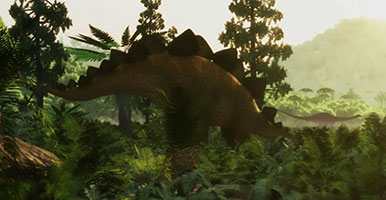
Find out what our scientists are revealing about how dinosaurs looked, lived and behaved.
See one of the world’s most complete Stegosaurus skeleton for yourself.
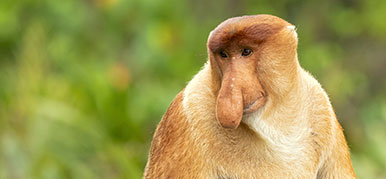
Just how weird can the natural world be?
Don't miss a thing
Receive email updates about our news, science, exhibitions, events, products, services and fundraising activities. We may occasionally include third-party content from our corporate partners and other museums. We will not share your personal details with these third parties. You must be over the age of 13. Privacy notice.
Follow us on social media